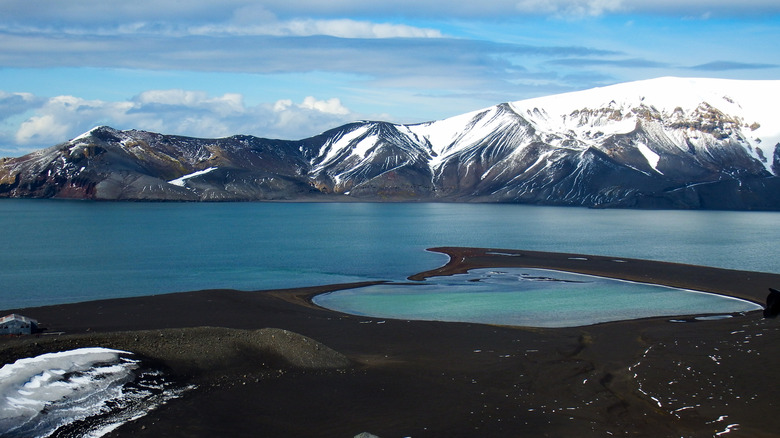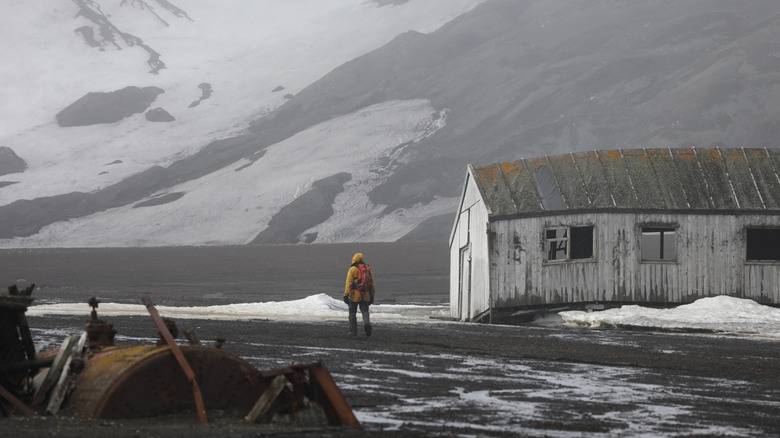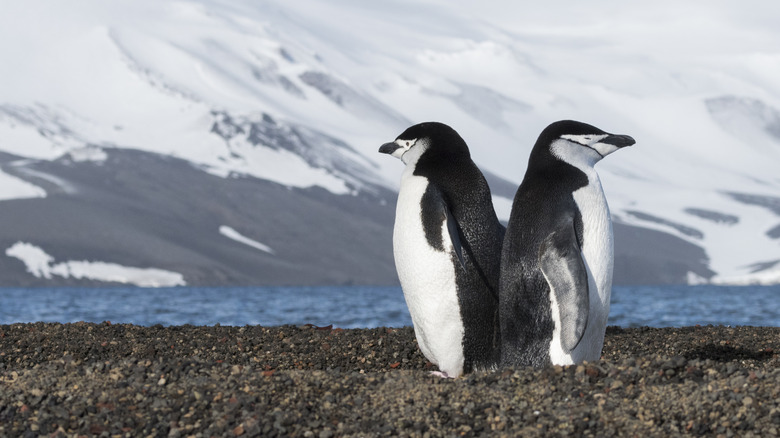One Of The Most Popular Antarctic Cruise Stops Is A Truly One-Of-A-Kind Volcano Island With Black Sand Beaches
Deception Island was aptly named; though it's just ten miles in diameter, it hides many secrets, and its appearance is certainly deceiving. From afar, it looks like any other island in the South Shetland chain, which lies north of the Antarctic Peninsula. But upon closer inspection, you see that it's actually horseshoe-shaped, with its narrow, half-mile-wide entrance (known as Neptune's Bellows) almost entirely hidden unless you're facing it. The natural harbor within, Port Foster, is enclosed by rocky walls and provides a safe haven for the many boats that moor here. But even this apparent safety is also deceiving — a flooded caldera, formed 10,000 years ago by a violent eruption, Port Foster is currently classified as a "restless caldera with a significant volcano risk."
This one-of-a-kind island, a popular cruise stop, is located around 65 miles from the mainland of Antarctica, one of the world's most expensive travel destinations. But beyond its status as one of just two active volcanoes on the White Continent, what makes it particularly special is that it's the only place on Earth where you can sail into the middle of a submerged caldera. It's a place of harsh but stunning beauty — ash-covered glaciers stretch across the land, and teal-colored crater lakes provide a striking contrast to the black sand beaches.
The island also serves as a breeding ground for chinstrap penguins, characterized by the narrow black band under their chin. The world's largest colony can be found on Baily Head, a hilly, snow-free promontory on the island's southwest edge. Between 50,000 and 100,000 breeding pairs of these helmeted creatures, along with other species of seabirds and seals, populate this rugged habitat. And although there are no human residents, the island has its fair share of ghost inhabitants — depending on what you believe.
Deception Island, Antarctica — past and present
In 1912, the Norwegian-owned Hektor Whaling Company set up a commercial station on the island. In the first year alone, they killed more than 5,000 whales and eventually hunted the blue whale to near-extinction. The station was abandoned in 1931, leaving behind only the rusting boilers and tanks (used to process blubber), discarded bones from the whales who met their untimely demise, and a cemetery holding the graves of 35 whalers.
In both 1967 and 1969, there were violent eruptions — perhaps the island's way of exacting revenge and taking back its land. Chile's scientific research station, Aguirre Cerda, and the cemetery were buried in the volcanic explosions and subsequent mudflows. Station B, an old British naval base, and several other buildings were also damaged. Following the lead of the Norwegians decades ago, the Chileans and Brits abandoned these posts, leaving remnants of the island's maritime and scientific past in their wake. Whalers Bay, Deception Island's oldest ghost town, is now a designated HSM (Historical Site and Monument). This place, which has seen much death and destruction, is so (allegedly) haunted that it attracted the crew of the TV series "Destination Truth," a reality show combining travel and supernatural investigation, to film an episode here.
But nowadays, you don't need to be an intrepid whaler, scientific researcher, or restless ghost to lay your eyes on this island within the seventh continent. You simply need to reserve your place on an Antarctic cruise, like this extraordinary adventure on the National Geographic Explorer with Lindblad Expeditions. Yes, this type of trip is pricey, but it's worth the cost for an out-of-this-world voyage to the most remote place on the planet.
How to visit Deception Island and Antarctica
Antarctica has a relatively short travel season, as the winter brings freezing-cold weather (temperatures can drop to -76 degrees Fahrenheit), sunless days, and large amounts of sea ice, which are dangerous for boats. Cruises, also called expeditions, are offered in the austral summer (early November 'til the end of March). Each month provides a different experience; December, for example, offers midnight sun and longer exploration time, whereas March is the best time for whale-watching.
As the continent isn't owned by any country and is governed by the 1959 Antarctic Treaty (which has 46 signatory nations), no hotels are permitted here, and it cannot be accessed by private boats. To visit, you'll need to book an expedition with a vessel authorized by IAATO (International Association of Antarctic Tour Operators); at the time of writing, there are 102 registered vessels. You can find anything from massive cruise ships shuttling thousands of guests through the Drake Passage (with no stops) to intimate yachts accommodating as few as 10 people. Finding the ship that fits your travel style, comfort level, and desired activities is the best way to enjoy this continent's captivating beauty. That said, it's also possible to fly in and camp, and there are even a few unbelievably dreamy luxury pods that you can stay at in Antarctica.
Whichever tour you book, check the itinerary in advance if visiting Deception Island is a high priority, as not every boat stops here. Additionally, be aware that any Antarctica cruise schedule will be subject to change. Remember, you are heading to one of the most extreme locations on Earth, through a highly dangerous stretch of water (the Drake Passage), and itineraries may need to be adjusted due to inclement weather, ice conditions, new regulations, or other safety-related factors.


